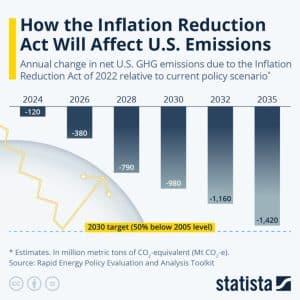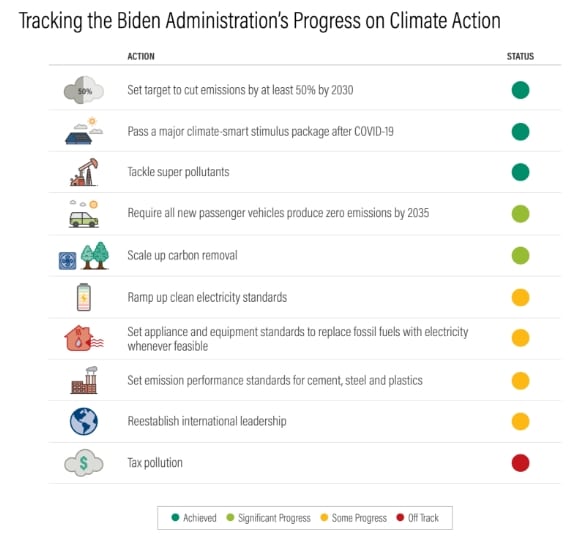President Joe Biden’s decision to withdraw presidential election this Sunday marks a significant turn in American politics. During his tenure, the country has seen the introduction, establishment, and amendment of numerous climate policies involving massive investments. The past four years under the Biden administration have been eventful from a climate change perspective. Let’s refresh our memory on the climate agendas rolled out by this government.
Key Highlights of Biden’s Climate Change Plan
“That’s why, when people talk about climate, I think jobs. Within our climate response lies an extraordinary engine of job creation and economic opportunity ready to be fired up. That’s why I’ve proposed a huge investment in American infrastructure and American innovation to tap the economic opportunity that climate change presents our workers and our communities, especially those too often that have — left out and left behind.”
-Remarks by President Biden at the Virtual Leaders Summit on Climate Opening Session (source: The White House)
Rejoined the Paris Agreement
From day one, Biden initiated the process for the U.S. to rejoin the Paris Agreement. The U.S. officially re-entered the agreement shortly after. Biden issued an executive order on tackling the “Climate Crisis at Home and Abroad”, creating the position of Special Presidential Envoy for Climate and announcing several high-level climate summits. Later, he set a target to reduce carbon emissions by at least 50% below 2005 levels by 2030. That was a historic announcement!
Signed the Inflation Reduction Act
He signed the Inflation Reduction Act in August 2022. Notably, it’s one of the most critical climate agendas of America. It includes significant investments in climate protection, such as tax credits for households to reduce energy costs, funding for clean energy production, and incentives to lower carbon emissions. The administration concentrated on creating tax credit guidelines and initiating programs to execute its various clean energy measures. To achieve excellence in climate action, they needed to maintain prompt and fair implementation of the legislation while also filling policy gaps.
Climate-Smart Stimulus Package to Revive from COVID-19.
Biden proposed a $2 trillion climate-smart stimulus package to boost the domestic economy, create jobs, and expand America’s clean energy sector. It surpassed the investments made in the 2009 economic recovery package. He prioritized modernizing the electricity grid, electrifying schools, and transit buses, enhancing the transportation system, upgrading public schools, boosting industrial innovation, and restoring trees to the landscape.
Biden committed to ensuring that at least 40% of the funding benefits go to the less-privileged communities. These investments targeted both short-term and long-term emissions-reduction goals. They installed solar, wind, heat pumps, and electric vehicles to cut costs. At the same time, they invested in future technologies which included the heavy emission sectors like steel, geothermal systems, and clean hydrogen.
Curb Hydrofluorocarbons (HFCs) and Methane Action Plan
The President ratified the Kigali Amendment to reduce hydrofluorocarbons (HFCs) in September 2022. The EPA issued regulations to phase down HFCs under the American Innovation and Manufacturing Act of 2020.
In November 2022, the Biden administration updated the Methane Action Plan with 50 measures supported by $20 billion from various laws. The Inflation Reduction Act introduced a methane emissions fee for oil and gas facilities, starting in 2024 and increasing to $1,500 per metric ton by 2026. At the 2023 UN climate summit (COP28), the administration announced strict standards to reduce methane emissions from the oil and gas sector. On January 12, 2024, the EPA proposed rules to enforce this fee.
Biden helped launch the Global Methane Pledge at the 2021 UN Climate Summit (COP26). By December 2023, 155 countries had committed to cutting their methane emissions by at least 30% by 2030.
source: World Resources Institute
Biden’s Milestones for the Energy Sector
Offshore wind was a crucial part of Biden’s promise to combat climate change that would generate jobs and enhance the economy. Biden approved the first U.S. offshore wind project and set new standards to cut methane emissions, which will prevent the equivalent of 1.5 billion tons of CO2. The American Clean Power Association (ACP) projected around 14 GW of offshore wind capacity along U.S. coastlines by 2030. This fell short of the 30 GW goal set by President Joe Biden’s administration in 2021 to boost the domestic energy industry.
Biden and the EPA introduced national carbon pollution standards, mandating a 90% reduction in emissions from coal and new gas plants. They also modernized the federal environmental review process under the National Environmental Policy Act (NEPA). The rule introduces a new permit for efficiencies from the Fiscal Responsibility Act of 2023.
Biden also transformed the energy-efficiency standards for residential water heaters. These standards cut energy waste and carbon pollution. He envisioned that this would save nearly $1 trillion over 30 years and reduce utility bills by $100 or more per year for the average family.
Image: EIA projects renewables share of the U.S. electricity generation mix will double by 2050
Finally, Biden signed the ADVANCE Act in July this year to support advanced nuclear technologies and the continued operation of existing nuclear plants. Recently, President Biden signed The Prohibiting Russian Uranium Imports Act to strengthen America’s energy and economic security, and eventually eliminate reliance on Russia for nuclear power.
Investments in CDR projects
On May 19, 2022, the U.S. Department of Energy (DOE) announced a $3.5 billion funding opportunity from the Bipartisan Infrastructure Law to capture and store CO2 directly from the air. The Regional Direct Air Capture Hubs program supported four large-scale hubs with carbon dioxide removal (CDR) projects. These hubs created jobs, engaged communities, and advanced environmental justice. Alongside other decarbonization efforts, this technology played a key role in achieving President Biden’s net-zero economy goal by 2050.
Curbing Transport Emissions
During his early tenure in 2021, Biden signed the bipartisan Infrastructure Act, allocating over $100 billion for rail, mass transit, charging stations, and zero-emission ferries and buses.
On March 29, 2024, the Biden-Harris Administration finalized the historic greenhouse gas standards ever for heavy-duty vehicles. This action protects public health, addresses the climate crisis, and keeps the American economy moving. The EPA adopted new emission rules for cars, aiming to cut 50% of CO2 emissions by 2032 and mitigate 7 billion tons of CO2 in the next 30 years. This rule can eliminate more GHG emissions than any other climate rule in U.S. history.
This year EPA also issued carbon emissions limits for heavy trucks, estimating a prevention of 1 billion tons of CO2 emissions. It introduced 3,400 electric school buses, and Biden released $1.7 billion for electric vehicle manufacturing. Additionally, the government released new standards for biofuels.
Despite global challenges, the U.S. has set strong examples in tackling climate change. President Joe Biden’s groundbreaking initiatives have significantly transformed the climate landscape. As America approaches a new presidential term, we hope the new leader continues to take responsible actions and drive further progress in combating climate change.
- FURTHER READING: Multi-Billion Dollar U.S. Clean Energy Tax Credits Are Here





